Acknowledgments A s I study Washi papers quiet and unobtrusive progression through centuries of Japanese experience, I stand in awe of the impact it has made, not only on Japan but now on the entire world. During that progression it played a key role throughout the development of the country, touching every feature of Japanese life. I have learned that over the years, a close relationship between papermaker and paper users developed, resulting in Washi becoming an integral part of the Japanese culture. As a result of this progression the skills that have been passed down from generation to generation produced a functional, yet extraordinary paper that reflected the soul and spirit of Japan. Japan today has mastered the art of living with the best of both worlds by infusing centuries of tradition into the modern technological world we live in today. The traditional aspects of Washi crafting are being adaptedor adoptedin peoples daily lives as creative Washi projects are being displayed at international exhibitions, art fairs, and workshops throughout America and the Western world.
The reputation of this handmade Japanese paper is growing by leaps and bounds because of its versatility, beauty, and power as an expressive medium that appeals to the visual, tactile, and emotional senses of crafters all over the world. My Washi craft journey has taken a relatively small amount of time in comparison and continues to be dependent upon the involvement of my students and colleaguesthose wonderful individuals, young and old, who sit in my Washi classes and dare to venture into the abstract world of Washi to create new and exciting works of art. Without their patience and eagerness it would have been utterly impossible to continue the Washi journey. Their support and continued encouragement has enabled us to navigate into new territory in Washi creativity and style. To all of them I owe a great deal of gratitude and appreciation. They truly are global partners in the world of Washi crafts.
Through Washi crafts, the bridge of friendship and understanding between many cultures continues to be the high point of all classes, gatherings, and social settings.  I want to also acknowledge Tuttle Publishing for its support and insightful promotion of the beautiful Washi craft. I thank my editor Amanda Dupuis for her expertise, enthusiasm, and hard work in bringing Holiday Paper Crafts from Japan to print. Finally, I dedicate this book to my families, the Uhls and the Boarmans. Robertta A. Uhl Okinawa, Japan
I want to also acknowledge Tuttle Publishing for its support and insightful promotion of the beautiful Washi craft. I thank my editor Amanda Dupuis for her expertise, enthusiasm, and hard work in bringing Holiday Paper Crafts from Japan to print. Finally, I dedicate this book to my families, the Uhls and the Boarmans. Robertta A. Uhl Okinawa, Japan
Shopping
for Washi All around the world, the changing seasons are marked with joyful celebration.
Christmas commemorates one of the most important festivals of the year, even in Japan. Many Japanese department stores are decorated with Christmas trees, twinkling lights, and holiday music just like the stores in many other parts of the world. Even though Christians are a minority in Japan, the Japanese love festivals and Christmas coincides with many of the end-of-year events of gift giving around December and January each year. Like all of us, the Japanese enjoy giving unique and creative gifts. The wonderful holiday gifts in this craft book will help the creative crafter to surprise friends and loved ones with handmade gifts in their favorite holiday colors. Since Washi is the main material in all of the crafts in this book, choosing the design and pattern is particularly important.
Study the craft that you would like to make and find the design and pattern that will show off the color and design of that Washi. If a pattern is too large it will disappear when making a small ornament, whereas if it is small and you can clearly see the details, it will show off the craft you are making. Likewise, if you are making a large craft, you will need to pick the appropriate paper to best highlight the larger scale of the project. The choices are endless and often the search for the right paper is just the beginning of enjoying the creative process. You will find that there are very few traditional Christmas-themed Washi, but many of the wonderful designs and colors will work well for the holidays. 
 Sizes: The standard size of a full sheet of printed Washi is 26" x 39" (66 x 99 cm).
Sizes: The standard size of a full sheet of printed Washi is 26" x 39" (66 x 99 cm).
Some companies make smaller sheets, so it is wise to measure the sheets before buying. Some stores sell their printed Washi rolled up in plastic packaging with the size marked on the plastic cover. In Japan, the larger craft stores display their Washi flat in drawers or loosely folded and placed on specially designed wooden shelves.  One-way patterns: Some printed Washi papers have definite one-way patterns. You will need to take this into account when doing certain projects. It is wise to buy a little extra printed Washi to ensure that the pattern is able to go in the same direction all around your project.
One-way patterns: Some printed Washi papers have definite one-way patterns. You will need to take this into account when doing certain projects. It is wise to buy a little extra printed Washi to ensure that the pattern is able to go in the same direction all around your project.
Economizing: When purchasing printed Washi, it is more economical to purchase full sheets than smaller pieces. If you want to have a variety of printed patterns at your disposal, try getting together with a group of friends to purchase a large number of full sheets of printed Washi that can then be divided up among the group, sharing the expense.  Borders: Full sheets of printed Washi have a solid, unprinted border around the outer edges. These edges should not be discarded but kept for covering the holes when making Washi-covered eggs. Internet sites: Washi has become very popular in recent years and there are a large number of Washi sites on the internet that sell Washi paper of all kinds, as well as instruction kits and books. Some of the more popular sites are www.washiart.com, www.kura.com, www.shizu.com, www.aitoh.com, www.kimscrane.com, and www.ichiyoart.com.
Borders: Full sheets of printed Washi have a solid, unprinted border around the outer edges. These edges should not be discarded but kept for covering the holes when making Washi-covered eggs. Internet sites: Washi has become very popular in recent years and there are a large number of Washi sites on the internet that sell Washi paper of all kinds, as well as instruction kits and books. Some of the more popular sites are www.washiart.com, www.kura.com, www.shizu.com, www.aitoh.com, www.kimscrane.com, and www.ichiyoart.com.
The forthcoming site www.washiways.com will carry my books Japanese Washi Paper Crafts and Holiday Paper Crafts from Japan, selected Washi paper packets for specific craft items, kits, and supplies.
Washi-Covered Glass Ornaments D iscover the eloquence of turning old ornaments into Washi treasures. Covering plain glass ornaments with beautiful Washi is a holiday delight that will fill your home with the richness of the many colors of Washi while extending the life of the ornaments. This conversation piece will inspire your friends to do the same with their old glass ornaments.

EQUIPMENT AND MATERIALS FOR SIX ORNAMENTS Six 2 / " (5.5 cm) or 2 / " (6.5 cm) or eight 1 / " (4 cm) glass ornaments / sheet of printed Washi Gold spray paint (optional) Small paintbrush White craft glue Tap water Small cup or bowl for mixing glue Measuring tape Tracing paper and pencil Small sharp scissors Damp kitchen towel or washcloth Wooden dowel (12" long x / " / 30.5 x 1 cm) TIPS Dont throw away any old Christmas ornaments! Buy new ones only after the holidays when they go on sale, or pick them up at flea markets for very little money. To prevent the ornament color from showing through the design of the Washi, it is best to cover a red ornament with printed Washi that has a red base, a blue ornament with blue-base printed Washi, and so on.

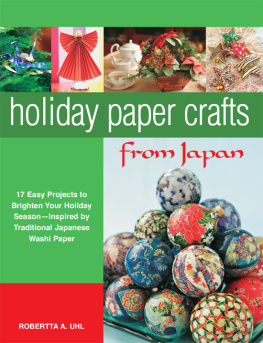

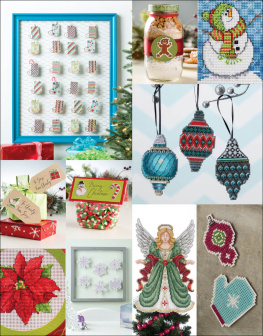

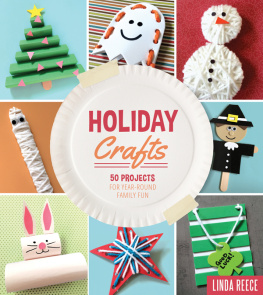
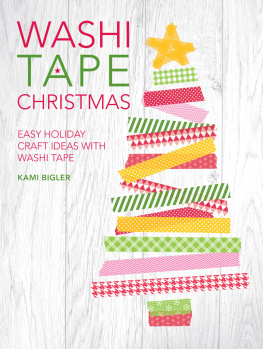
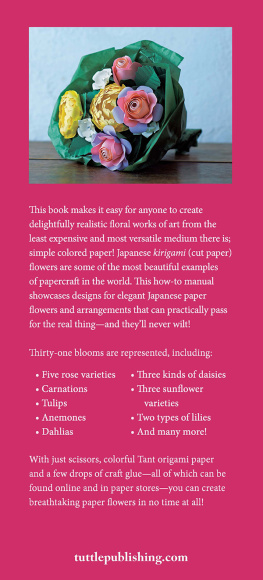

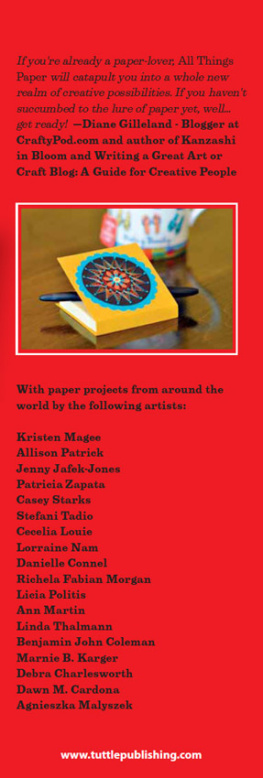
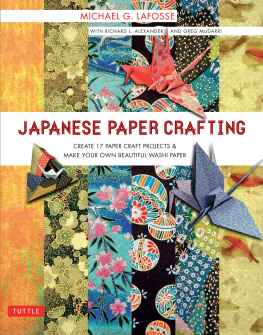
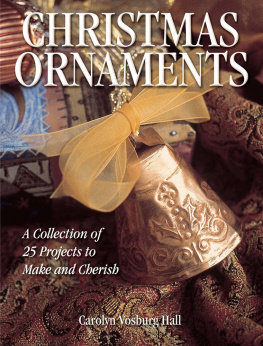
 I want to also acknowledge Tuttle Publishing for its support and insightful promotion of the beautiful Washi craft. I thank my editor Amanda Dupuis for her expertise, enthusiasm, and hard work in bringing Holiday Paper Crafts from Japan to print. Finally, I dedicate this book to my families, the Uhls and the Boarmans. Robertta A. Uhl Okinawa, Japan
I want to also acknowledge Tuttle Publishing for its support and insightful promotion of the beautiful Washi craft. I thank my editor Amanda Dupuis for her expertise, enthusiasm, and hard work in bringing Holiday Paper Crafts from Japan to print. Finally, I dedicate this book to my families, the Uhls and the Boarmans. Robertta A. Uhl Okinawa, Japan

 Sizes: The standard size of a full sheet of printed Washi is 26" x 39" (66 x 99 cm).
Sizes: The standard size of a full sheet of printed Washi is 26" x 39" (66 x 99 cm). One-way patterns: Some printed Washi papers have definite one-way patterns. You will need to take this into account when doing certain projects. It is wise to buy a little extra printed Washi to ensure that the pattern is able to go in the same direction all around your project.
One-way patterns: Some printed Washi papers have definite one-way patterns. You will need to take this into account when doing certain projects. It is wise to buy a little extra printed Washi to ensure that the pattern is able to go in the same direction all around your project. Borders: Full sheets of printed Washi have a solid, unprinted border around the outer edges. These edges should not be discarded but kept for covering the holes when making Washi-covered eggs. Internet sites: Washi has become very popular in recent years and there are a large number of Washi sites on the internet that sell Washi paper of all kinds, as well as instruction kits and books. Some of the more popular sites are www.washiart.com, www.kura.com, www.shizu.com, www.aitoh.com, www.kimscrane.com, and www.ichiyoart.com.
Borders: Full sheets of printed Washi have a solid, unprinted border around the outer edges. These edges should not be discarded but kept for covering the holes when making Washi-covered eggs. Internet sites: Washi has become very popular in recent years and there are a large number of Washi sites on the internet that sell Washi paper of all kinds, as well as instruction kits and books. Some of the more popular sites are www.washiart.com, www.kura.com, www.shizu.com, www.aitoh.com, www.kimscrane.com, and www.ichiyoart.com. EQUIPMENT AND MATERIALS FOR SIX ORNAMENTS Six 2 / " (5.5 cm) or 2 / " (6.5 cm) or eight 1 / " (4 cm) glass ornaments / sheet of printed Washi Gold spray paint (optional) Small paintbrush White craft glue Tap water Small cup or bowl for mixing glue Measuring tape Tracing paper and pencil Small sharp scissors Damp kitchen towel or washcloth Wooden dowel (12" long x / " / 30.5 x 1 cm) TIPS Dont throw away any old Christmas ornaments! Buy new ones only after the holidays when they go on sale, or pick them up at flea markets for very little money. To prevent the ornament color from showing through the design of the Washi, it is best to cover a red ornament with printed Washi that has a red base, a blue ornament with blue-base printed Washi, and so on.
EQUIPMENT AND MATERIALS FOR SIX ORNAMENTS Six 2 / " (5.5 cm) or 2 / " (6.5 cm) or eight 1 / " (4 cm) glass ornaments / sheet of printed Washi Gold spray paint (optional) Small paintbrush White craft glue Tap water Small cup or bowl for mixing glue Measuring tape Tracing paper and pencil Small sharp scissors Damp kitchen towel or washcloth Wooden dowel (12" long x / " / 30.5 x 1 cm) TIPS Dont throw away any old Christmas ornaments! Buy new ones only after the holidays when they go on sale, or pick them up at flea markets for very little money. To prevent the ornament color from showing through the design of the Washi, it is best to cover a red ornament with printed Washi that has a red base, a blue ornament with blue-base printed Washi, and so on.